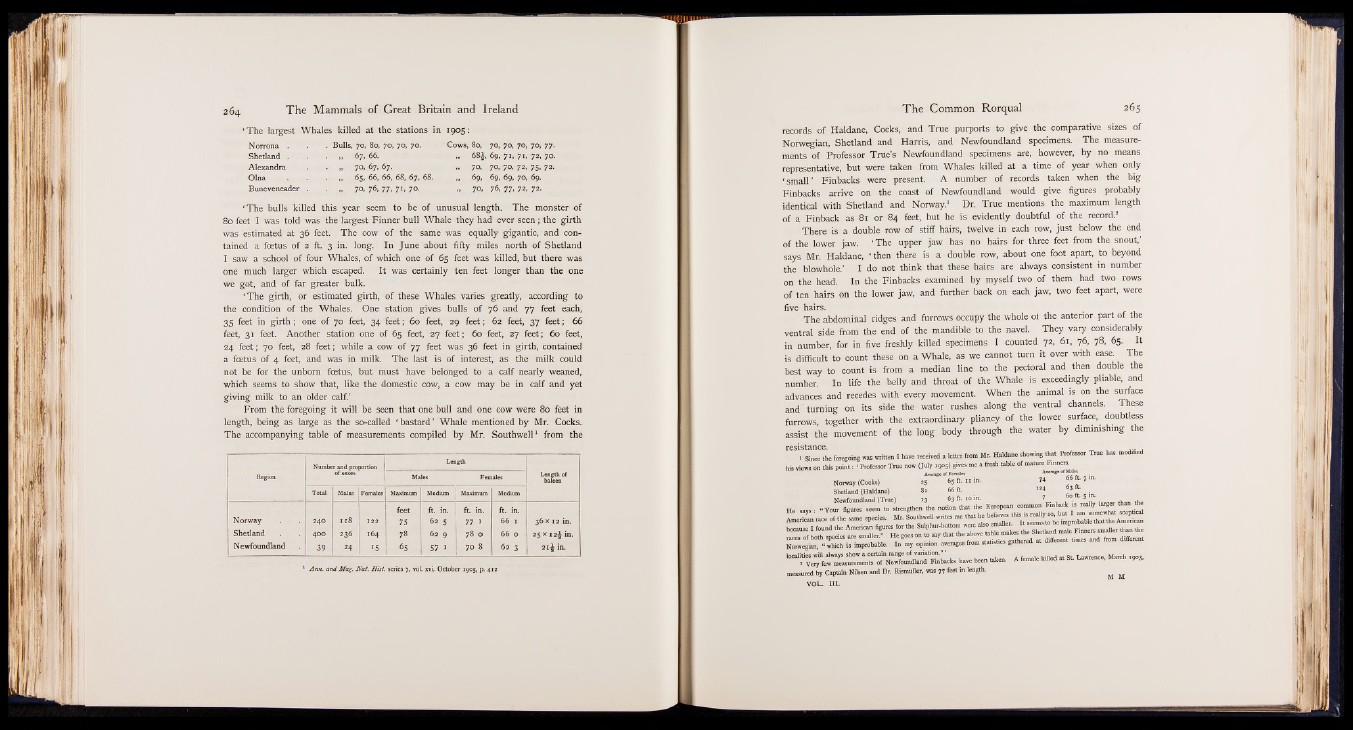
‘ The largest Whales killed at the stations in 1905:
Norrona .
. Bulls, 70, 80, 70, 70, 70.
Shetland .
. „ 67. 66.
Alexandra
» 70, 67, 67.
Olna
Buneveneader
. „ 65, 66, 66, 68, 67, 68.
• » 70, 76, 77. 71. 70.
Cows, 80, 70, 70, 70, 70, 77.
<•': ; Ü 68|, 69, 71, 71, 72, 70.
,, 70, 70, 70, 72, 75, 72.
„ 69, 69, 69, 70, 69.
» 70, 76, 77, 72, 72.
‘ The bulls killed this year seem to be of unusual length. The monster of
80 feet I was told was the largest Finner bull Whale they had ever seen ; the girth
was estimated at 36 feet. The cow of the same was equally gigantic, and contained
a foetus of 2 ft. 3 in. long. In June about fifty miles north of Shetland
I saw a school of four Whales, of which one of 65 feet was killed, but there was
one much larger which escaped. It was certainly ten feet longer than the one
we got, and of far greater bulk.
‘ The girth, or estimated girth, of these Whales varies greatly, according to
the condition of the Whales. One station gives bulls of 76 and 77 feet each,
35 feet in girth ; one of 70 feet, 34 feet ; 60 feet, 29 feet ; 62 feet, 37 feet ; 66
feet, 31 feet. Another station one of 65 feet, 27 feet ; 60 feet, 27 feet ; 60 feet,
24 feet ; 70 feet, 28 feet ; while a cow of 77 feet was 36 feet in girth, contained
a foetus of 4 feet, and was in milk. The last is of interest, as the milk could
not be for the unborn foetus, but must have belonged to a calf nearly weaned,
which seems to show that, like the domestic cow, a cow may be in calf and yet
giving milk to an older calf.’
From the foregoing it will be seen that one bull and one cow were 80 feet in
length, being as large as the so-called ‘ bastard ’ Whale mentioned by Mr. Cocks.
The accompanying table of measurements compiled by Mr. Southwell1 from the
Region
Number and proportion
of sexes
Males Females Length of
Total Males ; Females Maximum Medium Maximum Medium
feet ft. int i ft. in. ft. in.
Norway 240 I18 122 75 62 5 7 7 ,.4 ‘ü 66 I 36 X 12 in.
Shetland 400 236 1 164 78 62 9 78 0 66 0 25 X Ï2-J in.
Newfoundland 39 y 15 65 5 7 1 l g 7° 8 62 3 2i£ in.
1 Ann. and Mag. Nat. H ist, series 7, vol. xvi. October 1905, p. 412
records of Haldane, Cocks, and True purports to give the comparative sizes of
Norwegian, Shetland and Harris, and Newfoundland specimens. : The measure-
ments of Professor True’s Newfoundland specimens are, however, by no means
representative, but were taken from Whales killed at a time of year when only
‘ small’ Finbacks were present. A number of records taken when the big
Finbacks arrive on the coast of Newfoundland would give figures probably
identical with Shetland and Norway.1 Dr. True mentions the maximum length
of a Finback as 81 or 84 feet; :but he is evidently doubtful of the record.“
There is a double row of stiff hairs, twelve in each row, just below the end
of the lower jaw. ‘ The upper jaw has no hairs fS th r e e feet from the snout,’
says Mr. Haldane, ‘ then there is a double row, about one foot apart, to beyond
the blowhole.’ I do not think that these hairs are always consistent in number
on the head. In the Finbacks examined by myself two of them had two rows
of ten hairs on the lower jaw, and further back on each jaw, two feet apart, were
five hairs.
The abdominal ridges and furrows occupy the Whole of the anterior part of the
ventral side from the end of the mandible to the navel. They vary considerably
in number, for in five freshly killed specimens I counted 72, 61, 76, 78, 65. It
is difficult to count these on a Whale, as we cannot turn it over with ease. The
best way to count is from a median line to the pectoral and then double the
number. In life the belly and throat of the Whale is exceedingly pliable, and
advances and recedes with every movement. When the animal is on the surface
and turning on its side the water rushes along the ventral channels. These
furrows together with the extraordinary pliancy bf the lower surface, doubtless
assist the movement of the long body through the water by diminishing the
foregoing was written I bar. received a letter from Mr. Haldane showing that Profestmr Tree has modified
his views on this point: ‘ Professor True now (July 1905) gives me a fresh table of mature
Norway (Cocks) 25 . 6s It. rr in. 74 . v6 ? ‘0‘
Shetland (Haldane) 81 66 ft. ” 4
He says' I 'Y o ^ f i ^ '^ m ^ t r e n g t h e n * e notiol that the European common Fintack is really l a r g e . J j J
have been taken. A female kified a. St Lawrence, March rpog,
measured by Captain Nilsen and Dr. Rismuller, was 77 feet in length.